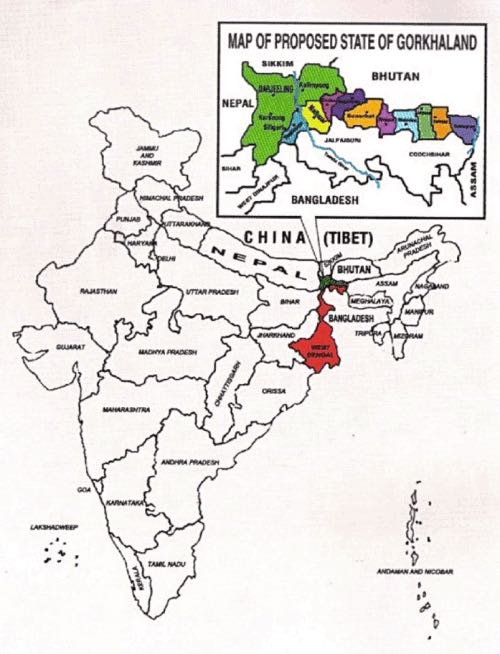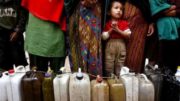The Larger Debate
India is a land of unity in diversity – often it is boasted. Truly, India is a multi-ethnic, multi-cultural and multi-lingual area. The society in the area is made up of various elements drawn from diverse origin. The social diversity is perhaps the most powerful manifestation of the area. The social groups with diverse ethnic and linguistic origins representing various racial stocks and social status have found places for themselves at different points of time adapting themselves to different ecological niches offered by the Physiographic and climatic setting of the area. The waves of immigration have drawn the ancestors of the majority of the present population of the area from the surrounding territories and across the Himalayas. Their dispersal has resulted in a creation of a social mosaic with ethnic distinctiveness. With such diversity in the area in terms of ethnicity, culture and language, the region is composed up of groups and sub groups with varied and diverse demands and needs. The primary responsibility of the State as an agent of development and planning is, thus, to take heed of the diverse requirements of social groups, not only of the majority social groups but also the groups in minority, residing within the length and breath of its territory. It is argued that ethnic expressions are in one way or the other related to development strategies adopted by a State and hence the failure and disparity in development strategies makes the association with the State less worthwhile and generates a multiplicity of separate ethnic expressions.
True to the above argument, over the years, the failure and disparity in development strategies (i.e. development planning) in India has led to the generation of multiplicity of separate ethnic expressions like Gorkhaland movement, Bodo movement, Uttarakhand Movement, Jharkhand movement and many others. And often it is observed that the agitating ethnic groups are in minority, have a distinct culture, language; they are geographically isolated, socially, economically and political insecure and have a low self-perception compared to those occupying the state berth.
Moreover, sociologists believe that the ethnic movements in India are essentially based on the perceived need to overcome poverty as against the conventional sociological arguments that the prospects of advancements enhance the utilization of ethnic identity.
Careful examination of the ethnic expressions in India reveals the importance of planning for development in ethnic and linguistic lines. There is a need for development plans to address ethnic and linguistic factors besides economic aspects. This becomes particularly true and relevant in a country like India where we talk of unit in diversity. The popular phrase that India is a land of unity in diversity itself suggests identification of diversities and giving due respect to them – which the planners misunderstood over the years.
Darjeeling Hills in Historical Perspective
The first access of human in the Darjeeling Hills and when who fell down the first tree to establish a living has not clearly been brought to book. But when British came here, it was inhabited merely by a few hundred souls in the pure natural environment, between the undiscovered flora and fauna.
Historically, the British Government of India acquired the district of Darjeeling from two neighbouring States of Sikkim and Bhutan. This small and beautiful territory, which once belonged to the Kingdom of Sikkim, was snatched away by Bhutan in 1706 (Kalimpong and the adjoining Dooars region) and Nepal by 1800 (Darjeeling and the Terai part which today includes the Siliguri subdivision).
Along with a part of Kalimpong and Dooars (Terai), Darjeeling was under the King of Sikkim prior to 1706. The Bhutanese snatched the present Kalimpong area in the same year. During the middle of the 18th century the Gorkhas won Sikkim along with the Terai. While the East India Company was busy expanding their territories in the south, Nepal had already become a strong nation by expanding its areas from Teesta to Kangra along with several plain areas in 1800. In 1816 Sugauli Treaty was signed and thus Nepal handed over Sikkim and its Terai part to the British. Shortly followed the Treaty of Titleya, and on the 10th February 1817 Sikkim and the Terai was returned to the King of Sikkim making it a buffer State. At this stage Darjeeling (proper) was a small village under the Kazi (minister) of the King of Sikkim.
It was in 1827 when Captain Lloyd and Grant, on the way to settling a dispute between Nepal and Sikkim, visited Darjeeling and discovered its invigorating climate. The healthy climatic condition was favorable for the establishment of the winter capital and military base. On the effort of Lloyd, the Governor General Lord Bentick started the dialogue with the King of Sikkim. On the 1st of February 1835, the king of Sikkim, with a view to enabling the British servants avail the healthy weather of the place, presented Darjeeling, what was to him a worthless uninhabited mountain, to the British Government, as a token of friendship. Darjeeling in 1836 was a small market of a few mat roofed houses popularly known as GOONDRI BAZAR. Due to the various political tensions between the Kingdom of Sikkim and the British India the tarai part of Sikkim, which forms the present Siliguri subdivision was also annexed by the British in 1850. Kalimpong subdivision along with the adjacent dooars was annexed to the British India in 1865 following the Indo-Bhutanese war of 1864.
The hills of Kalimpong after its brief inclusion in the Jalpaiguri district were included in the Darjeeling district in 1866 leaving out the dooars. In 1880 the subdivision of Siliguri was taken out from the Jalpaiguri district and included in Darjeeling district. Thus it was only in 1880 that the present shape of Darjeeling took its full shape. However, the geopolitical placement of the district kept on changing from time to time. The district of Darjeeling was annexed to Rajshahi (now in Bangladesh) after 1850. In 1905 the region in the present shape was included in the Bhagalpur of Bihar (Bengal, Bihar and Orissa being undivided) but to be taken away to Rajshahi again in 1912 and for that matter to Bengal after independence.
History of Administrative Negligence
The district of Darjeeling belonged to the non-regulated province before 1861; that is to say, Act and Regulations did not come into force unless they were specially extended to it. Under the system, the Governor General possessed the power of adopting legislation for the non-regulated provinces by means of executive orders.
Although, the district was included under the general regulation system for a brief period of 1861-70, on account of certain reasons (like the desirability of the preservation of indigenous system of land tenures which would break up if subjected to normal processes of litigation under civil courts without knowledge or experience of them; and the necessity of formulating simple laws conforming to the native institutions keeping in view the simplicity of the people of the area), the Act of 1870 once again took it out of the regulation system.
However, such administrative set up for the Darjeeling district that was considered as the less advanced district was only for a short period of time from 1870-74. Along with such other districts the district was brought under the purview of the Scheduled Districts Act, 1874 (also called the laws local Extent Act). As per the provision of the Act, in the listed districts the normal legislations and jurisdiction were in force only in part or with modification if necessary of any enactment in force at the time in any part of British India. The Act specified five district including Darjeeling of the then Bengal and others elsewhere to be described as the Scheduled districts.
The administrative arrangement as led down for the Scheduled districts including the district of Darjeeling remained unchanged for a quite a long period. The Indian Council Act of 1909 brought about no changes in this respect, too. However, it was in 1919, the Government of India Act, although retaining almost all the provisions provided for Scheduled district and their corresponding administration, put all the Scheduled districts under a new terminology, that is, ‘the Backward Tracts’. The Act further empowered the Governor General in Council to entrust to the Governor of Bengal the sole responsibility of administering the areas named as the Backward Tracts and in the context, to determine if any law of the Bengal legislature was applicable with or without modifications or exceptions as the Governor might decide or was not applicable at all.
Thus in accordance with the Act of 1919 the district of Darjeeling was a Backward Tract and remained so till the passing of the Government of India Act, 1935 which declared the district along with some others as a partially excluded area. No Act either of the federal legislature or of the provincial legislature was to be extended to either the excluded or the partially excluded areas until and unless the Governor of the province concerned would give his assent to the application of the Act in its entirety or with such modifications or exceptions as he thought necessary. In addition, the governor was empowered to make regulations for such areas for their peace and good government and the regulations thus made could annul any federal or provincial or Indian law in existence in case of their non-conformity to the relations thus made.
Such administrative arrangement that provided the district of Darjeeling the status of partially excluded areas remained till the attainment of the independence by India. Thus it becomes possible to assert that the district of Darjeeling had been kept outside the purview of general administration and that it remained more or less isolated throughout the greater part of British rule in India.
The partition of Bengal in August 1947 left the boundaries of the district intact and in the share of West Bengal. The district was placed thereafter in the Presidency Division. Under the Constitution of India the district no longer enjoys special privileges. All statutes except the Bengal Tenancy Act in certain of its particulars, apply to it. The Deputy Commissioner of Darjeeling is now also the District Magistrate and has to be notified as such in the official Gazette when a new DC is appointed. However, under the statue of the state of West Bengal Darjeeling district enjoys a special status in that the district is governed through two development agencies namely, District Collectorate and the Darjeeling Gorkha Hill Council formed following the precedence of the DGHC Act, 1988.
Search for Ethnic Identity in Darjeeling Hills
As long ago as in 1907, the people of Darjeeling had felt that the district of Darjeeling had been devoid from the purview of general administration and were kept relatively isolated throughout from the central rule. Under the leadership of the different regional political organizations the people of Darjeeling hills made repeated demands (1907, 1920, 1929, 1930, 1934, 1947, 1952, and 1955). Through their demands they expressed their will to break away from Bengal. Demands, worth noting and which were relatively systematic, put forward from time to time till the mid 1950s may be highlighted as below-
- Separate Administrative Unit directly administered by the Centre,
- Separate Province comprising of the district of Darjeeling and the neighbouring areas,
- Inclusion of Darjeeling district with a section of Jalpaiguri viz. the Dooars in Assam.
The reasons, which impelled the people of this district to demand a break away from West Bengal, had been put forth in all the memoranda submitted to the Central Authority from time to time. Some of the noteworthy reasons put forward by these local political organizations may be highlighted as follows-
- Historically speaking, the district of Darjeeling never formed a part of Bengal and no King who ruled the plains of Bengal ever had any suzerainty over those areas.
- Ethnologically speaking, the Mongoloid and semi Mongoloid races inhabiting the district of Darjeeling and greater part of Jalpaiguri have more affinity with the Hill tribes of Assam than with the people in the plains of Bengal.
- Geographically the district of Darjeeling, Jalpaiguri and Cooch Behar are completely cut off form the main body of West Bengal creating inconveniences in matter of large transport and other overland communications, which in times of crisis may create serious delays and difficulties.
- Linguistically, the people residing in the hill areas in question have greater affinity with Hindi, the Lingua Franca of India, than with the state language and the average student find themselves burdened with too many languages in their curriculum of study.
- Administrative inconvenience.
- The University of Calcutta had not conceded the demand for recognition for Nepali as a major language although the University of Patna had accorded such recognition.
Besides, T. B. Subba (1992), a noted anthropologist, remarks,
“Long years of interaction between the hill communities and the plainsmen (mainly the Bengalis) had more to do with the above demands than anything else. On the one hand these communities had already developed various sorts of interdependence, agrarian and trade being two most important in this regard. Then there was the Nepali language to express themselves with each other and lay the foundation of hill ethnicity. On the other hand, they suffered from certain politico-economic disadvantages vis-a vis the plainsmen. Besides whatever little communication that took place between the hill men and the plainsmen being through the English or Hindi language such an interaction was limited to the educated class and businessmen”.
Further, Subba asserts that ” the argument that the Bengalis in particular often behaved as a masters in Darjeeling hills cannot be easily brushed aside…Had their attitude towards the hill people been healthy the latter would probably have no strong reason to seek a separation from the former” .
Synthesis of Historical Causes for Gorkhaland Movement
If we analyse the historical events that gradually led to the ethnic movements in Darjeeling Hills following points emerge:
The geopolitical situation in the District of Darjeeling had (have) never been stable. The district passed through a number of vulnerable positions and different events in history, each having a marked effect in the region and its people.
Moreover, the administrative history of the district clearly reveals that it was a non-regulated region even prior to the passing of the Indian Council Act, 1861 . The district retained this status till 1874. The Laws Local Extent Act, 1874 made Darjeeling a Scheduled district, which remained so till 1919. The Act of 1919 declared Darjeeling as a backward tract. It remained so till 1935 when it ultimately became a partially excluded area under the Government of India Act, 1935 and remained in that conditions till the independence of India.
Thus, we can safely assert that, throughout the British rule the rulers on any occasion never allowed the district to come within the national mainstream and within the purview of the general administration. Despite the occasional opposition by the hill folks, the British government followed the policy of segregating the district from the administrative, legislative and judicial system of the rest of Bengal and India at length. Slowly but steadily, dissatisfaction over such negligence of the authorities became pronounced with time.
As the people of Darjeeling hills were in minority and predominantly poor working mainly as labourers and army jawans the British Indian Government never took heed of their desires and demands. The treatment of the district of Darjeeling in a special way for years for various reasons directly or indirectly inculcated within the people of the district a sense that their ultimate security would rest in a separate administrative arrangement made especially for them.
Thus, we see, since immediately after the turn of the 19th century the manifestation of the dissatisfaction started coming in the form of memoranda seeking for the separate administrative set up and regional autonomy. The first of such memoranda came as early as in 1907 put forward by the “leaders of the hill men” of Darjeeling district. This was the starting point of the ethnic movement in the history of Darjeeling. Till the independence of India and even after the independence numerous memoranda were put forward to the authorities concerned demanding separate administrative unit, regional autonomy, separate state and even separate nation outside the territory of India, depending on the nature and ideology of the local political organizations. One of the most notable aspects in the long history of the ethnic movement in Darjeeling is that they were non violent till mid 1986.
The formal establishment of Gorkha National Liberation Front (GNLF) in July 1980 under the leadership of Shri Subash Ghisingh led to the establishment of a more systematic demand for a separate statehood for the district of Darjeeling and the adjoining dooars areas of Jalpaiguri. The whole of the general mass residing in the hill areas along with the other subordinate organizations like Pranta Parishad and Swantantra Manch strongly supported this demand. The demand was for the first time invoked in 1980 under the strength of Article 31 of the Indian Constitution. It is important to borne in mind that till the mid to 1986 the movement was absolutely nonviolent. Violence was probably unavoidable when the state refused to understand the language of memoranda, plays, poetry and songs. The same was the case with respect to Assam, Mizoram, Meghalalya, Nagaland, and Manipur. The various ethnic movements in those places turned violent only after the people were pushed to the wall.
People died, women became widow, education suffered, economy declined, environment degraded and many such vices took their birth between the 27th July 1986 and 22nd August 1988. The movement for the separate state of Gorkhaland was withdrawn and the output that the people of Darjeeling hills got out of it was the Darjeeling Gorkha Hill Council, which still exists before us.
Why are the people not satisfied with DGHC?
The issue can be debated at two levels.
First, Darjeeling Gorkha Hill Council as a unit of development made especially for the socio economic advancement of the hill people of Darjeeling district has a structure of a federated unit within a larger federation. Its composition is to a large extent similar to that of the states within the Indian union. The state government of West Bengal acts as central federation. As far as the structure is concerned it has all the characters of a state. However, with regard to the powers and functions it is subject to the approval and ratification by the government in almost all the matters. The examination of its powers and functions highlights its position not much ahead of the zilla parishad. Besides, there are important party political uncertainties and dependencies that compromise the power of the council.
Although as an agent of development it enjoys freedom to prepare development plans and budgets for the hill areas all the laws and by laws in this regard passed by the Council cannot be implemented unless approved by the government. It is also that they have to be drawn at par with the priorities and broad principals envisaged in national and state five year plans. Thus, the reality is that the centre or state can always reject or force reformulation of Councils priorities, plans and programmes. Funds still flow through the state government including the central fund. Often the late release of funds by the state makes it impossible for the council administration to carry out the programmes.
DGHC, moreover, has not been created under the statute of the parliament. It has been created under the state legislature possibly to prevent the uncontrollable agitation and violence, thereby, in the Darjeeling hills. It is therefore a political creation rather than a Constitutional one. No part of the Indian Constitution was amended in this regard and hence the Indian Constitution does not talk of the existence of DGHC in any part within the territory of India.
Secondly, DGHC in the last two decades has been unable to prepare integrated development plans for the hill areas. The development plans prepared so far over the years are Sectoral and hence lopsided in nature. Sectors to gain major emphasis so far include road construction, tourism and primary education. Sadly, all the attempts in this regard have been a massive failure. Unscientific and unplanned construction of roads in this ecologically fragile region has led to increased landslides and soil seep over the years. Development of strategic and eco-friendly tourism has been far from appreciation. Primary education has suffered lot due to local party politics. To give a classic example in this regard – in the year 1995 DGHC with the approval of government conducted interviews for the appointments of primary teachers within the hill areas of Darjeeling. Till date the appointment has not been completed. No one knows the total number of vacancies to be filled. Examination at the micro-level highlights the fact that a bribe of approximately one lac is being demanded for each post by the authority empowered for the purpose.
While DGHC was formed to address the geographical differences (in terms of social, economic, political, cultural and historical geography) assuming congruence of location and community other minor differences which are, in fact, the most important and often unrecognized as communities like occupation, age, gender, class are barely or not at all addressed.
It is also that the spatial division of the district into hills (DGHC) and plains (Siliguri dub-division) has negatively impacted the hill economy. Siliguri since history has been serving as an economic hub in the region and thus as a major trading and commercial centre it not only influences the hill economy of Darjeeling district but also plays an important role as a commercial linkage between Northeast India and mainland and between Nepal/Bhutan and India. Hence, excluding Siliguri away from the functional jurisdiction of DGHC would adversely impact the long-term development process in the Darjeeling hill region.
In addition the presence of two administrative and planning units in Darjeeling has been creating more of confusions rather than scientific and efficient development in the region. Each unit assumes that it is superior with more power to the other thus pushing efficient planning and development to the back seat. Therefore, conflicts lack of cooperation, unnecessary interventions on each other’s business and most importantly superiority complex between the district collectorate and DGHC are the forces that have been seriously hindering the advancement of this backward tract even today. The main sufferers in this situation are the development units below the district, i.e. Municipalities, Blocks and Villages that work under the direction and guidance of DGHC and district collectorate. In a way it is the general mass that are suffering, ‘yet again’.
The executive powers with reference to primary, secondary and higher secondary education has been conferred in DGHC the powers related to secondary and higher secondary education still lies with the state government and thus DGHC has no say in this regard so far till date. This has led to appreciable conflicts between the state government and the council in recent times. The School Selection Commission of West Bengal in this regard provides an appropriate example. DGHC in the last many years has blocked all the appointments made by SSC in secondary and higher secondary institutions in the hill areas within its functional jurisdiction thus adversely impacting the education system in the region. Similarly, the other major conflict areas between the state and the DGH include forest, land and transportation.
Finally, there is no agreement locally on the direction and kind of development that is deemed appropriate for Darjeeling Hills and is controlled by few local politicians. Hence, the much-hyped concept of local and community level participation and people empowerment are at the backseat. It should be remembered that DGHC was created in order to meet the demand of local community, for a stronger voice of the people in decision-making, planning and implementation of development objectives. DGHC has not been able to resolve these problems but rather exacerbated it. The villagers, farmers, and the weaker sections or to be more precise the general mass are largely kept away from the decision and thus the planning process and have no voice in the formal structure of the Council.






Leave a comment